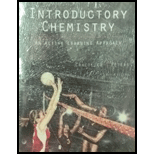
Concept explainers
Interpretation:
The normality of sodium carbonate solution of volume
Concept introduction:
An acid base reaction is one of the types of reaction which is known as neutralization reaction. Normality is used to express concentration of any solution. The n factor of any species is defined in different way depending upon the type of reaction. In an acid base reaction n-factor is defined as the number of replaceable
Answer to Problem 105E
The normality of sodium carbonate of volume
Explanation of Solution
The equation which is used to calculate the normality of sodium carbonate is given below.
The molarity is given by the formula shown below.
Substitute relation (2) in (1) as shown below.
Where,
•
•
•
•
•
•
Benzoic acid has
The given value
The given value of
The given value of
The given value of
The given value of
Substitute all the values in the equation (2) as shown below.
Relation between molarity and normality is written below.
Where,
•
The calculation of normality of sodium carbonate is shown below.
Therefore, normality of sodium carbonate of volume
The normality of sodium carbonate of volume
Want to see more full solutions like this?
Chapter 16 Solutions
Bundle: Introductory Chemistry: An Active Learning Approach, 6th + LMS Integrated for OWLv2, 4 terms (24 months) Printed Access Card
- Calcium carbonate, CaCO3, can be obtained in a very pure state. Standard solutions of calcium ion are usually prepared by dissolving calcium carbonate in acid. What mass of CaCO3 should be taken to prepare 500. mL of 0.0200 M calcium ion solution?arrow_forwardWhat kinds of solute particles are present in a solution of an ionic compound? Of a molecular compound?arrow_forwardEvery pure substance has a definite and fixed set of physical and chemical properties. A solution is prepared by dissolving one pure substance in another. Is it reasonable to expect that the solution will also have a definite and fixed set of properties that are different from the properties of either component? Explain your answer.arrow_forward
 Introductory Chemistry: An Active Learning Approa...ChemistryISBN:9781305079250Author:Mark S. Cracolice, Ed PetersPublisher:Cengage Learning
Introductory Chemistry: An Active Learning Approa...ChemistryISBN:9781305079250Author:Mark S. Cracolice, Ed PetersPublisher:Cengage Learning General Chemistry - Standalone book (MindTap Cour...ChemistryISBN:9781305580343Author:Steven D. Gammon, Ebbing, Darrell Ebbing, Steven D., Darrell; Gammon, Darrell Ebbing; Steven D. Gammon, Darrell D.; Gammon, Ebbing; Steven D. Gammon; DarrellPublisher:Cengage Learning
General Chemistry - Standalone book (MindTap Cour...ChemistryISBN:9781305580343Author:Steven D. Gammon, Ebbing, Darrell Ebbing, Steven D., Darrell; Gammon, Darrell Ebbing; Steven D. Gammon, Darrell D.; Gammon, Ebbing; Steven D. Gammon; DarrellPublisher:Cengage Learning Introductory Chemistry: A FoundationChemistryISBN:9781337399425Author:Steven S. Zumdahl, Donald J. DeCostePublisher:Cengage Learning
Introductory Chemistry: A FoundationChemistryISBN:9781337399425Author:Steven S. Zumdahl, Donald J. DeCostePublisher:Cengage Learning- Chemistry: Matter and ChangeChemistryISBN:9780078746376Author:Dinah Zike, Laurel Dingrando, Nicholas Hainen, Cheryl WistromPublisher:Glencoe/McGraw-Hill School Pub Co
 Introductory Chemistry: A FoundationChemistryISBN:9781285199030Author:Steven S. Zumdahl, Donald J. DeCostePublisher:Cengage Learning
Introductory Chemistry: A FoundationChemistryISBN:9781285199030Author:Steven S. Zumdahl, Donald J. DeCostePublisher:Cengage Learning Chemistry for Today: General, Organic, and Bioche...ChemistryISBN:9781305960060Author:Spencer L. Seager, Michael R. Slabaugh, Maren S. HansenPublisher:Cengage Learning
Chemistry for Today: General, Organic, and Bioche...ChemistryISBN:9781305960060Author:Spencer L. Seager, Michael R. Slabaugh, Maren S. HansenPublisher:Cengage Learning





